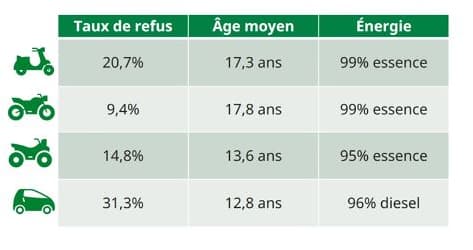At the start of the 2024 school year, the first test for the “new technical inspection” will take place. Since April 15, new categories of vehicles must pass this periodic health test, mainly motorcycles, scooters and cars without a license.
Registrations before 2017 open the dance
For this first year of implementation, vehicles registered before January 1, 2017 must complete this process. This had to be done by August 15 for those whose birthday (for all years prior to 2017) was before April 15. And by December 31 for those whose birthday is after April 15.
Next year, it will be the turn of vehicles whose first registration was made in 2017, 2018 and 2019. In 2026, those from 2020 and 2021. We will return to the normal frequency from 2027, with the first registrations taking place in 2022. In fact, the technical inspection will be carried out 5 years after the first registration and then every 3 years.
Almost 5 months after the start of the first controls, the Dekra Group (brands Dekra, Norisko and Autocontrol) carried out an initial evaluation of this measure on Thursday 12 September. In total, 485,626 vehicles underwent this L (light) category technical inspection, according to figures from the Ministry of the Interior, of which 23% were carried out at a Dekra Group centre.
Of this total, and according to figures as of 1 September, 2 wheels of 125 cm3 and above represented more than 80% of the controlled fleet. An L3 category which is more commonly known as a motorcycle.
Next in line is category L1, small scooters with less than 50 cm3, with 8.4% of the controls. This is followed by unlicensed cars (category L6), with 4.8%, and quads (category L7), with 3%. The other categories (L2, L4 and L5) represent just over 3% of the controls since 15 April.
A very variable rejection rate depending on the category
Although the implementation of this control generated many doubts, even strong opposition, many users feared that their vehicle would not receive this sesame.
During these first months, the results remain generally favourable, with a counter-inspection rate of 11.56% for this entire L category. A rate comparable to that of passenger cars, 19.4% since the beginning of the year and stable compared to 2023.
However, there are significant differences between categories. Motorcycles (L3) obtain the highest score with a 9.45% re-inspection rate, which pushes the average down.

In fact, the situation is worse for scooters (L1), with 20.70% having to undergo a second inspection. Among the main reasons for “major breakdowns” we find non-compliant, missing, damaged or poorly fixed plates, excessively worn or damaged tyres, as well as defective brake lights.
Problematic “old” people without a license
Finally, unlicensed cars are seen as fools with a 31.3% failure rate. Poor tyres emerge as the main cause of failure in the technical inspection for this L6 category, ahead of a defect observed in the shock absorbers and a problem with the wheel bearings which can degrade the stability of the vehicle.
“In the case of unlicensed cars, we know that the owners of these vehicles generally have low incomes, which does not allow them to purchase a licensed vehicle, and that they will also have difficulties in ensuring the maintenance of the vehicle, with spare parts that are sometimes very expensive,” stresses Karine Bonnet, Managing Director of Dekra Automotive.
It should be noted that these first unlicensed cars that passed this technical inspection are quite old models, with an average age of almost 13 years and a 96% Diesel engine.
It will be interesting to see whether this rejection rate decreases in the coming years, with newer models, including the famous 100% electric Citroën AMI or its cousin the Fiat Topolino, and parent-buyers with more means to maintain them.
This high rate of rejection of unlicensed cars was at least expected by professionals in the sector.
A “D system” interview
“These very particular drivers have always been accustomed to driving without being held accountable. The maintenance of these cars is often carried out by a cousin, sometimes even by a neighbour. It is not unusual to see windscreens held together with tape and bumpers with wire,” stressed Stéphanie Lecocq, director of Piecesanspermis.fr, a specialist in spare parts for cars without a licence, in a statement published before the implementation of this measure.
Modifications and system D which may logically conflict with this test, which aims to ensure the good health of the vehicle fleet circulating in France.
“These models are successful because many parents prefer them to two-wheeled vehicles, which seem too dangerous, but without maintenance, they are more dangerous,” stressed Bernard Bourrier, general manager of the Autovision and Motovision centres, who expressed concern at the beginning of May about the first worrying figures from the checks carried out on these vehicles.
Source: BFM TV


